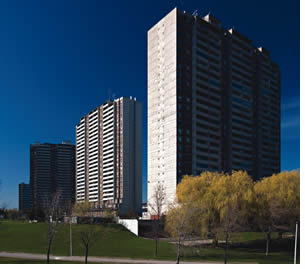Hundreds of thousands of Torontonians live in highrise apartment buildings constructed between 1950 and 1970. While structurally sound, the buildings lack insulation and have outdated heating and ventilation systems. They also lack recycling chutes. For a city aiming to conserve, these are significant problems – it’s too expensive and disruptive to tear down and start over.
The answer, according to Ted Kesik and Ivan Saleff, is renovation. For the last eight years, the University of Toronto architecture professors and building scientists have been developing ways to preserve and beautify the city’s 1,000 concrete slab apartments while also making them more environmentally efficient. Kesik says that the buildings are “extremely robust” from a structural point of view, even if they are now considered unattractive. Many have underground parking and indoor swimming pools, as well as great views of the city.
The Kesik and Saleff solution involves wrapping the towers in “new skin”: aesthetically pleasing overcladding that will support high-speed Internet cables and garbage separation chutes. The building scientists define “skin” as anything outside the building, such as walls, windows, roofs and balconies (these last are the towers’ corroding Achilles heels, and must be strongly reinforced). Replacing these elements could reduce the building’s energy consumption by up to 50 per cent and help cut the city’s greenhouse gas emissions. The process is intended to extend each building’s life by 50 years and can be implemented while tenants stay in the building in order to minimize disruption to their lives.
The proposal has the added benefit of preserving Toronto’s stock of affordable rental housing – in dwindling supply in a city where condos are beyond the reach of most low-income residents. Earlier this year, Mayor David Miller formally endorsed the scheme, launching the Mayor’s Tower Renewal Project, with Kesik and Saleff developing technical guidelines for the job. The mayor’s project intends not only to upgrade the buildings, but to fill in underused green spaces around them with urban agriculture, establish stores and community centres close by, and provide the towers with better transit service.
This could all take a long time, though Kesik estimates that four pilot buildings could be fixed up within 18 months. “A typical comprehensive retrofit of a 20-storey building costs from $4–$6 million and pays for itself in about 15 years,” he says.
Above all, Kesik is grateful that the project has allowed his team to marry ivory-tower theory with concrete-tower reality. “It’s so important to be engaged in issues that mean something to people,” he says.
Recent Posts
For Greener Buildings, We Need to Rethink How We Construct Them
To meet its pledge to be carbon neutral by 2050, Canada needs to cut emissions from the construction industry. Architecture prof Kelly Doran has ideas
U of T’s 197th Birthday Quiz
Test your knowledge of all things U of T in honour of the university’s 197th anniversary on March 15!
Are Cold Plunges Good for You?
Research suggests they are, in three ways





